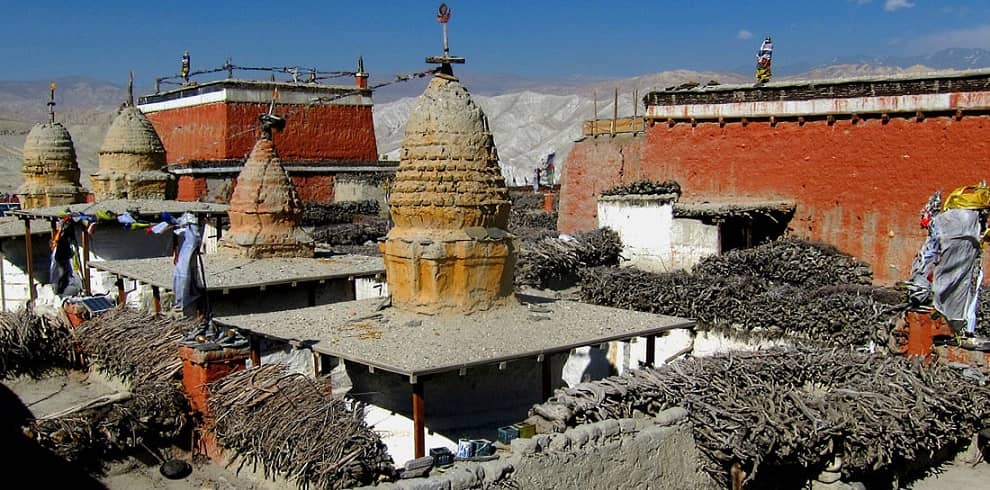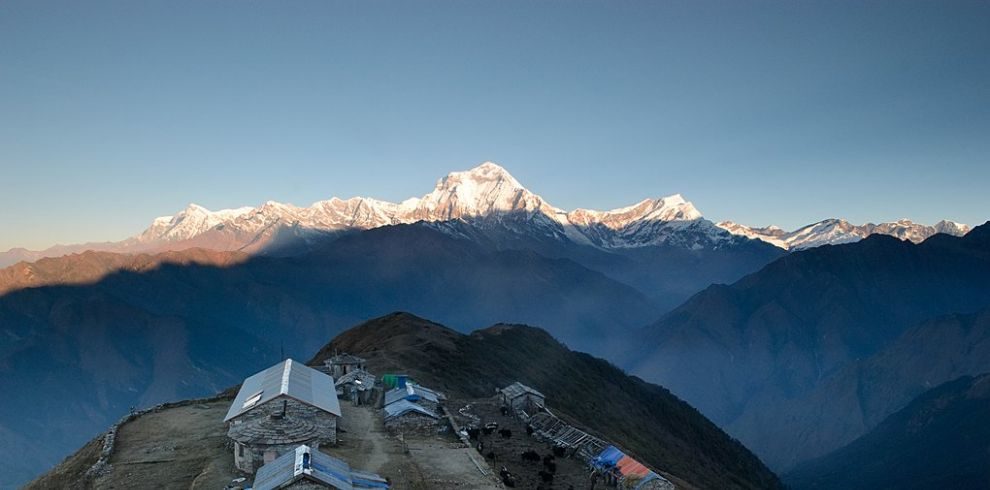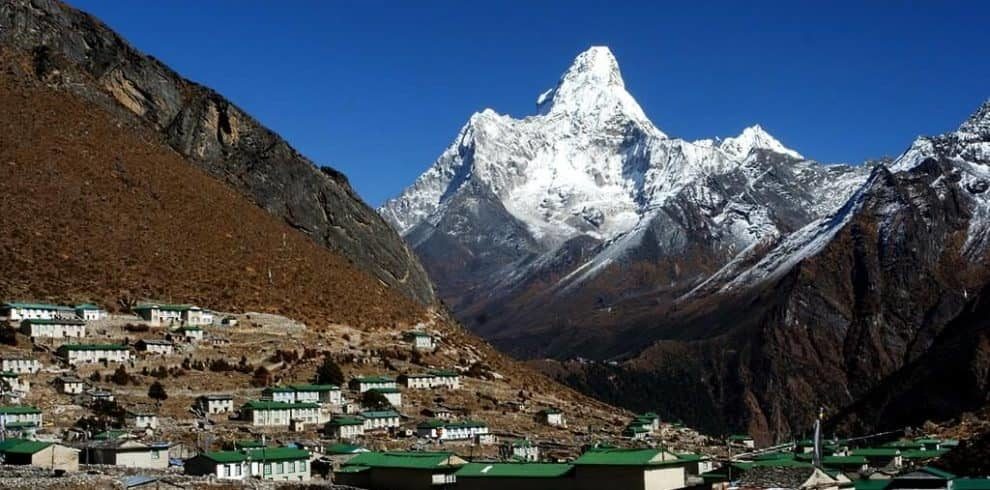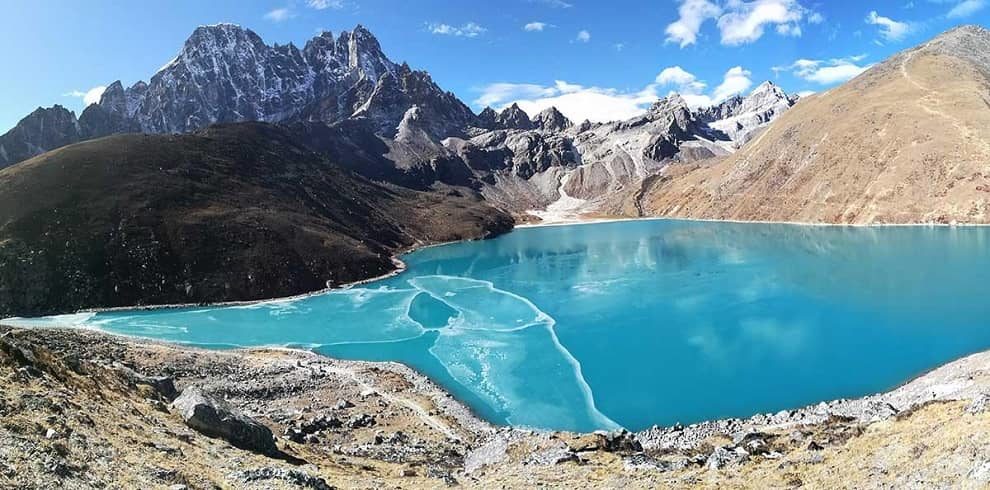Introduction To Upper Mustang Trek In Nepal
The Upper Mustang Trek is one of the most popular trekking destinations in Nepal which will take you to the restricted and isolated region of Nepal.
In the year 1992, the Upper Mustang area became accessible for treks and tourists. Mustang was, in fact, Nepal’s last forbidden kingdom, isolated for hundreds of years and developed its own distinct culture and customs.
This region is rich in historical and religious monuments, and its unique terrain sets it apart from the rest of Nepal, as it lies in the Himalayan rain shadow.
It is geographically part of the Tibetan plateau, and as a result, its culture is Tibetan rather than Nepalese.
Ancient caves, holy fossil rocks, parched plains, and cliffs can all be found in Upper Mustang. Lo Manthang, Upper Mustang’s ancient capital, is a small hamlet with roughly 150 dwellings, a palace, and a 200-year-old monastery called Lhakhang.
The Annapurna conservation area encompasses Mustang. As you travel to Upper Mustang, you’ll be able to see spectacular views of mountain peaks including Dhaulagiri (8167m), Annapurna I (8091m), and Manaslu (8,163m).
Your tour starts with a scenic drive from Kathmandu to Pokhara through mountains, traditional villages, terraced farms, and the turbulent Trishuli and Marsyandi rivers. Pokhara is Nepal’s tourist capital.
Views of several lakes and Himalayan peaks, including Dhaulagiri, Manaslu, and Lamjung Himal, may be found here. In reality, these mountains can be seen reflected in the lakes.
The following day, fly from Pokhara to Jomsom, the capital of Mustang. You can see Dhaulagiri and Annapurna, which are both over 8,000 meters tall, as you fly. You will hike to Kagbeni, the gateway to Upper Mustang, after landing in Jomsom.
We continue our journey to Chele after spending the night in Kagbeni. We’ll hike early in the morning to avoid the afternoon’s strong winds.
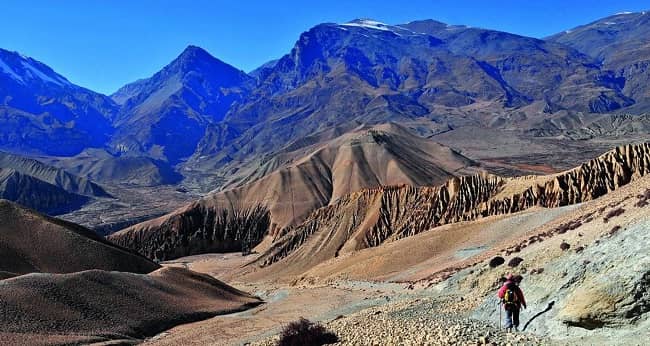
Because the hike sections might be windy and dusty, you should bring your sunglasses and a face mask. As you continue on your journey, you will pass through Tangbe village, and a short distance ahead is Chele, your goal for the day.
We will travel from Chele to Syangboche by a path that passes via the Eklo Bhatti village and the Taklam High Pass (3,625m / 11,940ft).
This walk is difficult because you will gain up to 800 meters. You’ll also pass through Samar, a village noted for its spectacular vistas of the Nilgiri mountain range.
The walk will then begin in Syangboche and end in Ghami. This time you’ll pass over the arid scenery of Yamda La Pass (3,845m/12,655ft) on your way to Geling, Tamagaun, and finally Ghami.
Tsarang, a village of about 1,000 people, is our next stop on the walk. Although the walk takes place in the driest area of Mustang, the scenery is breathtaking.
We will go from Tsarang to Lo Manthang, where you will be able to see the Nilgiri, Tilicho, Annapurna I, and Brikuti peaks. The trail climbs until it reaches Lo La Pass, then descends to Lo Manthang.
We’ll take a day off and explore Manthang. There are various places to see in Manthang, including gompas, palaces, historic temples, and more.
Our return journey begins after the eighth day. We leave Lo Manthang first and travel to Ghami. We’ll stop by the famed Ghar Monastery on our way to Darkmar.
On the ninth day, we leave Ghami and walk to Samar. To Geling, the path largely descends. However, we continue on to Samar, passing through Jaite and Chhukungkah.
Our trek will take us to Chhusang after Samar. On the way, there is a sacred place where Padmasambhava (Tantric Buddhist Master) is said to have meditated.
Muktinath is the next trek destination after Chhusang. You’ll pass the Gyu La Pass (4,077m) and begin the Annapurna Circuit Trek.
Muktinath is a Hindu and Buddhist pilgrimage place with 108 bathing spouts. A perpetual flame can also be seen glowing in the shrine.
We travel from Muktinath to Jomsom on our final day on the treks. The trail descends to Jahrkot and Khingar before arriving in Jomsom, near the mouth of the Kali Gandaki River Valley.
We’ll fly to Pokhara the next morning after spending the night in Jomsom. You have the option of spending a day in Pokhara or flying back to Kathmandu on the same day. If you spend a day in Pokhara, you will take a tourist bus back to Kathmandu the next day.
Highlights Of Upper Mustang Trek In Nepal
- Jomsom (2,720m/8,915ft) is the district capital of Mustang.
- Mt. Annapurna (8,091), Thorung Peak, Nilgiri (7,061), Chulu West, Chulu East, Tukuche Peak, Dhaulagiri (8,167m), Lamjung Himal, Annapurna II, and Annapurna IV Yak pastures, spectacular lakes, glaciers, gorges, and waterfalls
- Muktinath is a Hindu and Buddhist pilgrimage place.
- Mustang district, as well as the opportunity to interact with its residents
- Lo Manthang is the old kingdom of Mustang’s capital.
- Buddhist monasteries from the past
- A look at the Tibetan way of life
- A day in Pokhara, Nepal’s tourist capital.
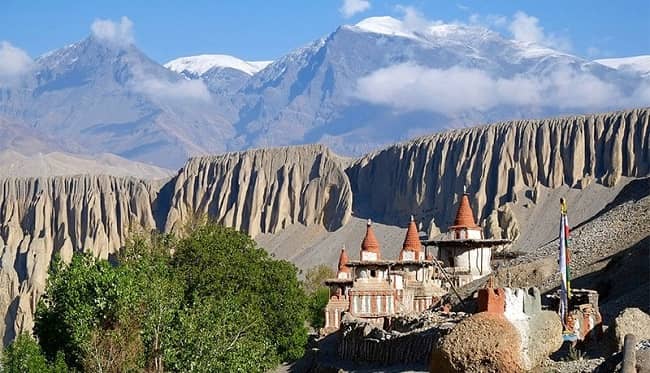
Benefits of Upper Mustang Trek In Nepal
- During your arrival, you will receive a complimentary transfer from the airport to your hotel, and vice versa during your departure.
- During the trek, surplus luggage can be stored for free at our stores.
- At high elevations, pulse oximeters are used to monitor blood oxygen saturation and detect early signs of altitude sickness.
- Medical kits in case of an emergency
- If you don’t have your own, sleeping bags and down jackets can be rented.
Equipment Checklist
Equipment list
We recommend that you bring only the essential clothing and equipment for the walk. For every two trekkers, we allocate one porter. Each trekker’s luggage is limited to 9kg. However, we expect you to bring your basics in a typical backpack. This packing list was created to assist you in picking up the necessities.
Head
- Scarf or hat for the sun.
- Winter hat, insulating hat, or hat with a wide brim.
- Extra batteries for the headlight.
Face
- Sunglasses with UV protection Sunglasses with UV protection.
- Wipes for the face and body.
- Hands.
- Gloves that are light in weight.
- Winter gloves with a lot of weight.
Body
- Shirts for hiking
- Shirt with a long sleeve
- Rain jacket with hood
- Lightweight cotton pants with a fleece jacket
- T-shirt (bring Lightweight wool)
- Underwear made of polypropylene
- Jacket with down feathers (available for rent in Kathmandu)
- Sweater
- Jacket and pants that are waterproof
Footwear
- Boots for Hiking.
- Socks made of thick wool (Take an extra pair of thick light socks).
Essential gear
- A daypack or a backpack (Size depends on whether you take a porter or not).
- Bottle with a heating element
- Purification of water
- Pole for hiking
- Bag for sleeping
Toiletries
- a drying towel of medium size
- Toothbrush \sToothpaste
- Floss with deodorant
- Biodegradable soap in a bar
- a pair of nail clippers
- Mirror
Personal accessories
- Money
- Watch
- Cell phone
- Camera
Extra items
- Kit for first aid
- Extra passport photographs and photocopies.
- Binoculars and a notebook
Trip Information
Upper Mustang trip start
You will arrive at Kathmandu’s Tribhuvan International Airport, where our representative will greet you. On the day of departure, we will board a tourist bus from Kathmandu to Pokhara at roughly 7 a.m.
We’ll pick you up from the airport.
On your arrival, we will pick you up from the airport and drop you off at your hotel in a private vehicle, and vice versa on your departure. Our agent will be holding a booklet with your name on it at the Tribhuvan International Airport. As a welcoming gesture, they will either give you a Khada or Marigold garland and then drive you to your accommodation. To take use of this free service, please provide your flight information.
Accommodation Details
This fifteen-day trek includes twelve nights of lodge-to-lodge accommodation in the trek zones and two nights in a Pokhara hotel. You will be staying in the greatest lodges that are offered.
At Kagbeni, Jomsom, Syangboche, Ghami(2N), Tsarang, Lo Manthang (2N), Chhusang, and Muktinath, we provide ten-night rooms with attached bathrooms. Two nights in a basic room in Chele, Samar (twin sharing basis).
You will stay in a hotel in Pokhara for two nights, with a room and adjoining bathroom, TV, 24-hour hot water, power, and laundry facilities.
We will reserve a single private room with a connected bathroom for solitary trekkers in available lodges and single private lodging in other locations.
Two nights of hotel accommodation in Kathmandu are required before and after the trek, however, this is not included in the package. There are hotels in Kathmandu to suit all budgets and interests.
Note that the package does not include lunch or dinner in Pokhara.
In the lodges/teahouses, hot showers and Wi-Fi will be offered for an additional fee.
Meals
Because you’ll be climbing at a high altitude, you’ll need a lot of nourishing meals. We will offer you with enough nutritional, tasty, and hygenic meals in the best hotels/restaurants, but as we trek to higher elevations, your options will become increasingly limited.
There are 14 breakfasts, 13 lunches, and 13 dinners included in this trek package.
The following are some of the most popular menu items:
Oatmeal, Corn Flakes, French toast with jam, butter, and cheese, Honey Tibetan bread or Chapati, and local Tsampa porridge are among the fourteen breakfast options. Fruits and vegetables, as well as eggs, pancakes, and muesli breads Drinks that are heated (varieties of teas and coffees, hot chocolates, etc.)
Thirteen meals, including Dhal, Bhat, and Tarkari, Tibetan Bread, Soups, Sherpa Stew, Steaks, Sandwiches, Momo (dumplings), Macaroni dishes, Tenduk Spaghetti Noodles, Thukpa, Pasta, Vegetable curry, Potatoes, Vegetables, Salad Pizza (Tomato, Mushroom, Mixed), Snacks (Papad, Prawn), Desserts
Dhal, Bhat & Tarkari, Tibetan Bread, Various Soups, Sherpa Stew, Steaks, Sandwiches, Momo (dumplings), Macaroni, Tenduk Spaghetti, Noodles Thukpa, Pasta, Vegetable curry, Potatoes items, Vegetable and Salad Pizza (Tomato, Mushroom, Mixed), Snacks (Papad, Prawn), Korean Raman, Desserts (R
At high elevations, we propose fresh vegetables and liquids such as hot lemon, green tea, lemon tea, ginger tea, and garlic soup (must).
Despite the abundance of non-vegetarian options accessible in trek locations, we do not advocate them due to meat quality concerns. At high elevations, we also recommend avoiding dairy and avoiding alcoholic beverages, caffeinated foods, and hot chocolates.
Note: Lunch and dinner in Pokhara are not included in this package (before flying to Jomsom).
All personal bills (alcoholic, hot (tea/coffee), and cold drinks) in tea houses, lodges, or cafés are excluded from the package, save for standard meals (breakfast, lunch, and dinner with seasonal fruits).
Best seasons to trek to Upper Mustang
When it comes to determining whether or not to go to Upper Mustang, the weather is the most important issue. Upper Mustang is visited all year, but particular seasons make the journey easier and more pleasurable. Summer and autumn treks are the most comfortable and provide the greatest vistas. Most locals leave Upper Mustang in the winter to avoid the cold and snow.
March to May (Spring)
Spring (March-May) is a popular time for mountaineers and travelers to visit Upper Mustang in big numbers. The weather is pleasant during this time of year, with daytime temperatures ranging from 16 to 22 degrees Celsius. The nights, on the other hand, are cooler, with temperatures dropping below 0°C Celsius.
June to August (Summer)
Summer in Nepal lasts from June through August, however, it also overlaps with the monsoon season. Upper Mustang, on the other hand, does not experience monsoons, making summer an ideal time to visit. Upper Mustang residents hold a horse celebration on the full moon day in August. Summer temperatures range from 16 to 25 degrees Celsius. Temperatures at night range from -3 to 0°C.
September to November (Autumn)
The Autumn sky in the Upper Mustang is clear, affording magnificent views of the mountains, as they are in other regions of Nepal, but afternoons can be windy. The daytime temperatures vary from 12 to 20 degrees Celsius, while the evenings are frigid, with temperatures ranging from -8 to -4 degrees Celsius.
December to February (Winter)
By November, the trekking season is done. To avoid the cold, the residents will travel to other areas, therefore the lodges will be closed. Furthermore, the snow has covered the paths, making trips nearly impossible.
Acclimatization
This journey includes a one-day respite at Lo Manthang to allow for proper acclimatization and avoid altitude sickness. Although altitude sickness is preventable, it can be lethal if the symptoms are ignored.
We’ve planned our route to allow the body to adjust to the new altitude slowly and steadily. Our hiking leaders/guides have all had rigorous first-aid training and have a lot of expertise.
At high altitudes, our team will routinely utilize oximeters to assess your blood oxygen level. We strongly advise all trekkers to notify their group leaders as soon as they see the first signs of altitude sickness.
We assure you that your health is in capable hands. Precautions will also be recommended by your hike leader or guide. The best strategy is to take your time when hiking and drink enough water throughout the day. The only way to recover from acute altitude sickness is to descend as soon as possible.
Please keep in mind that your group leader has the authority to determine whether or not to continue ascending if altitude sickness develops. It is critical to remember that certain individuals are more vulnerable than others.
Trip Grade: Fitness level, Medical, and Health
The trip to Upper Mustang Trek is difficult yet rewarding. Depending on your location, you’ll be hiking for 5 to 7 hours per day, with several stops to take in the scenery.
Long climbs, sharp descents, and forward trails through rocky slopes and through woods are all part of the journey routes. It will assist if you have previous trekking experience, but it is not needed.
Please keep in mind that the fitter you are, the more enjoyable the walk will be. As a result, we recommend that you participate in stamina-building exercises a few weeks before the walk.
This trek is not recommended for persons who have heart or lung problems. People with such issues should contact us before signing up for this expedition.
Trekking group/single
We organize both group and private treks. Group discounts are available dependent on the size of your group. The larger your group, the greater the savings. Please see our price list for further information. Simply click the – we offer group discounts – link on the right.
We can accommodate any size group. Each group will have a guide, and we will assign a porter to every two trekkers. We will provide an assistant guide for groups of 12 or more.
A typical trek day
Each day brings a new trekking adventure. You’ll be snapping photos and exploring the nearby communities while taking in the landscape. Throughout the trek, our knowledgeable and pleasant guides/Sherpas will be by your side. They will also provide you with information on the areas where you will be walking.
Porters will accompany our entire expedition crew to handle your bags. However, we ask you to bring a modest day bag with you that contains important and valuable items. Each day begins with a nice cup of tea or coffee in the morning. Following a hearty breakfast, we begin our day’s journey at about 7 to 8 a.m., depending on the length and nature of the hike.
We will serve lunch about midday on the way to the next destination after walking for three to four hours. We’ll take a break for an hour after lunch and then resume our trek. The trek in the afternoon is shorter, lasting two to three hours. We munch on the additional dietary food and tour surrounding locations till it becomes dark after we arrive at our overnight lodge/tea house/tent.
Dinner is served between 6 and 7 p.m. You can engage in polite chats and discuss the events of the day after dinner and before going to bed. Your trek leader/guide will give you an overview of the next day’s activities. You can read books, view mountaineering videos, or play games like monopoly and cards after this briefing. The majority of visitors like learning a little Nepalese from our personnel.
Communication during the trek
There is a nominal service charge to use the internet at the lodges. You will, however, communicate via phone at high altitudes for safety reasons.
At least once a day, our office communicates with all trek groups via trek leaders to learn about trek conditions. In Kathmandu, you can get a local sim card, although the signals may not be powerful enough depending on the network.
In teahouses/lodges, there is free Wi-Fi, but you must pay a service fee to utilize it.
Extra personal expenses during the trek
Although this package covers a substantial portion of the route, it does not cover all expenses. All of our valued clients will require spending money to cover expenses such as lunch and dinner in Kathmandu, visa application fees, travel insurance policy purchases, snacks, Wi-Fi, alcohol, hot (tea/coffee) and cold drinks, tips for trekking crew members, souvenirs, and other miscellaneous expenses. We recommend bringing cash (in the form of dollars) to exchange for rupees. Only Nepali money is accepted in trek areas.
Electricity and water during the trek
Electricity for camera and mobile phone recharge is available throughout the lodges on the way to Everest Base Camp. During the trip, you can purchase packed mineral water at local lodges and en-route shops, or fill your water bottle with boiled water for an additional fee at lodges/teahouses. If necessary, we can also give you a water-purifying pill.
We strongly urge you not to drink water from rivers, taps, or wells in trek locations because the water may not be safe to drink.
Travel insurance
This Upper Mustang Trek expedition requires travel insurance. Before beginning the hike, all trekkers must produce a copy of their comprehensive travel insurance policy certificate to us. Medical and emergency repatriation must be covered, as well as helicopter rescue and evacuation costs at high altitudes (up to 6000m).
Based on the experiences of our former clients, we may recommend insurance firms to you. We do not, however, sell insurance coverage. Within a week of booking the trek, we ask that all trek participants provide us with their comprehensive insurance information. In an emergency, we’ll prepare a speedy, successful rescue using your insurance policy and other documentation you supplied us.
Before you acquire travel insurance, call your provider and double-check that it covers helicopter rescue and evacuation up to 6000 meters. Do not rely solely on the material of the insurance company’s website.
Passport and visa
Except for Indian nationals, all foreigners must have a valid visa to enter Nepal. At Tribhuvan International Airport and Nepal’s borders with India and Tibet, you can obtain an on-arrival visa. Visit www.immigration.gov.np. for additional details.
You’ll need a passport that’s valid for at least six months, a passport-size photo, and visa fees to apply for a visa. A 30-day visa costs $50 at the moment (to be paid in cash).
A free visa will be given to children under the age of ten. It is strongly recommended that you examine the current regulations. Visa regulations are subject to change at any time. Citizens of China and members of the South Asian Association for Regional Cooperation (SAARC) (Bangladesh, Bhutan, India, Maldives, Pakistan, and Sri Lanka) are exempt from visa fees.
Certain countries’ citizens may be denied a visa upon arrival. On-arrival visas are not available for citizens of Nigeria, Ghana, Zimbabwe, Swaziland, Cameroon, Somalia, Liberia, Ethiopia, Iraq, Palestine, and Afghanistan. If you are a citizen of one of these countries, please contact the Nepalese Embassy in your country.
Before we embark on our journey, we’ll double-check everything (luggage, equipment, etc.) during our briefing.
Money exchange
Nepali Rupees (NPR/Rs) are the local currency.
(1 USD = ~ Rs.124 NPR).
You can exchange major foreign currencies through local banks and legitimate money exchanges in Kathmandu and all over Thamel. Legitimate money exchanges display their ongoing exchange rates visibly to the public.
Please note – only 100 INR (Indian Rupees) and 2000 INR notes are legal in Nepal.
Despite having the security advantage of traveler’s cheques, we prefer cash exchange. It helps avoid lengthy processes and high bank commissions.
You can withdraw cash (in Rupees)from ATMs all over Kathmandu and Thamel itself. Many of these ATMs are open around the clock. The maximum withdrawal amount is 35,000 Rupees for a 500 Rupees processing fee for foreign cards.
If you use the money exchange facilities at banks and financial institutions, they impose a service charge fee of about 4% or more.
During the trek, there are no banks and money exchange services so you should exchange your money in Kathmandu, depending on how much personal expense you require. Only Nepali Rupee is accepted in trekking regions.
Most established banks in Asia will only accept foreign currency notes that are not old, torn, or faded. Please ensure that you have new, clean notes.
How much luggage can I bring to the Trek?
The maximum luggage weight per trekker is 9 kilograms. One porter will be assigned to every two trekkers. The greatest weight that a porter can carry is 18 kg. We also anticipate you bringing a modest backpack to store crucial documents and valuables. You can leave your extra luggage for free at your hotel or at our store.
Please note that before beginning the adventure, we will review your gear, clothing, and equipment during the travel briefing.
Safety
Your safety and security are guaranteed by us. To protect your safety, we take many safeguards. We’ll be carrying all of the essential gear, equipment, and first-aid kits on the hike. Our trek leaders and guides have gone through comprehensive outdoor first aid training. If a trekker becomes ill, the trek leader has the ability to decide whether the trek should continue or be abandoned. In addition, we will hike together as a group.
Responsible travel
We are firm believers in environmental stewardship and make every effort to leave just our footprints in the trek areas. No trekkers will visit these locations tomorrow if we do not preserve them today. As a result, we only organize eco-tours. We collaborate with the Kathmandu Environmental Education Project (KEEP) to plan environmentally sustainable itineraries that fulfill the needs of both tourists and locals.
Our Crew
Our knowledgeable guide/Sherpa will accompany us on the trek to ensure your safety and comfort. Your stuff will be carried by porters.
Our members are locals from high Himalayan remote places, and they have exceptional physical endurance at high altitudes.
We value all of our employees, so we pay them well and take care of their insurance, clothing, food, and lodging throughout the trip. When our guides and porters become unwell or injured, they receive medical attention.
Only happy people can make others happy, thus we always make sure that our team members are happy. Members of our trek/expedition team have the following qualifications:
- Authorized Trekking Guide Training Certificate
- Intensive Wilderness First Aid Training
- Fluency in English and another major language
- Conservation and Biodiversity Training
- Experience with rock climbing
Tipping
Tipping is accepted in Nepali culture. Tipping is a wonderful way to express gratitude for the service you’ve received. Tipping, on the other hand, is up to the trekker’s discretion and should be commensurate with the level of service received. We invite you to go on a vacation together and at the finish.
Booking and payment process
We are a government-approved and bonded trek and tour company in Nepal. We are also members of the Nepal Mountaineering Association (NMA) and the Trekking Agency Association of Nepal (TAAN) (NMA). As a result, you may book your trek/expedition with complete trust.
As a deposit, we require 10% of the total trip cost. Within a week of booking, please send your documentation, including a copy of your passport, passport-size pictures, travel insurance policy, and arrival and departure flight information.
You can make a 10% deposit via bank transfer, western union, or online payment on our website, and the full balance when you arrive in Nepal. Cash, bank transfer, and credit cards are all acceptable methods of payment. In addition, you will receive payment choices in your email.
Last-minute booking
Even though it is always a good idea to plan ahead for your excursions. However, for those who are unable to do so, we provide a special last-minute booking option. To take advantage of this benefit, you must pay the entire trip cost 24 hours before the trek’s departure.
Even while we do our best to plan treks at any time, there is a small potential of a trek delay due to events beyond our control, such as the inability to obtain air tickets or unfavorable weather.
Trip extension
If you wish to stay in Nepal for a few days after the trip, we can arrange enjoyable activities for you, such as exploring areas in and around Kathmandu, Chitwan jungle safari, paragliding, rafting, canoeing, and so on.
Feedback
We offer a farewell meal at the end of the trek, and we will also award you with a trek completion certificate after dinner (hard copy). It’s also a great opportunity to tell us about your experience and provide us feedback.
You may also visit Annapurna Circuit Short Trek-Cost, Distance, Itinerary, In Nepal – 10 Days
Overview Of Upper Mustang Trek
- Upper Mustang is a dry river valley in the Himalayan rain shadow region near the Annapurna Circuit. This valley used to be a prohibited kingdom within Nepal. Trekking into the higher Mustang is a rare and fortunate opportunity, with thousand-year-old monasteries, chortens, and gompas blending into the landscape as spiritual wonders.
- Upper Mustang is a sacred and remote region of Nepal’s Mustang District in the Himalayas. This journey is comparable to the Tibetan Plateau hike in that it allows you to discover the magnificent countryside. This hike can be done as a camping trip, a teahouse trip, or a trip to a nearby resort
- During the Upper Mustang Trek, we may see how actual Nepalese mountain people live, with a Tibetan influence. This circuit is off the beaten route in terms of authentic Himalayan adventures, and we can savor the undisturbed views and solitude of the mountain’s local traditional community.
